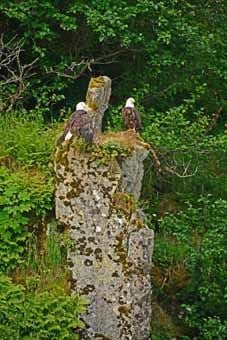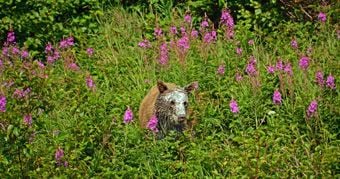Day one
Shelikof Strait and Kukak Bay, Katmai National Park
Jul 22, 2019 - National Geographic Orion
 A cow-calf pair of resident killer whales crosses our bow in Shelikof Strait.
A cow-calf pair of resident killer whales crosses our bow in Shelikof Strait. National Geographic Orion at anchor in Kukak Bay, Katmai N.P.
National Geographic Orion at anchor in Kukak Bay, Katmai N.P. A coastal brown bear cruises the coastline for food.
A coastal brown bear cruises the coastline for food. A female brown bear cools off in the waters of Kukak Bay.
A female brown bear cools off in the waters of Kukak Bay. A flock of Barrow’s golden eyes takes flight over Kukak Bay.
A flock of Barrow’s golden eyes takes flight over Kukak Bay.
Our first full day of this epic, 20-day Alaskan-Russian itinerary started with a bang, and a blow! First thing this morning a string of bushy breaths on the horizon materialized into a pod of 12-15 resident killer whales in the middle of Shelikof Strait, the body of water separating Kodiak Island from the Alaska Peninsula.
Sunny skies and calm seas, glaciated peaks on the horizon and all eyes were on the ocean. It only took a few close passes to see this was a fairly large group of whales of mixed ages. Some were only a few years old and others full adults. One adult male had a dorsal fin so large it couldn’t hold it upright as it leaned to the side at every surfacing.
With our morning destination looming on the horizon we excused ourselves from our first charismatic megafauna sighting of the trip for another.
On the muddy banks of Kukak Bay, within the southern boundary of Katmai National Park we found bears. Big, fuzzy, hot brown bears. These famous residents of this area all busy foraging on clams, mussels and other slimy morsels beneath the intertidal rocks – completely uninterested in our presence. When the effort of lifting 50–100lb stones from the banks of the bay became too much, the bears went off would cool themselves in the balmy waters, seemingly appreciative of their access to the sea on warm days such as these.
An iconic part of the world ushered us into Alaska, and we get the pleasure of spending another day here tomorrow. May the bear sightings continue!!
Day Two
 Several bald eagles were found and photographed during the Zodiac tours. One in this photo was holding its wings out as if drying them. Perhaps it inadvertently went for a swim.
Several bald eagles were found and photographed during the Zodiac tours. One in this photo was holding its wings out as if drying them. Perhaps it inadvertently went for a swim. Two young brown bears, probably siblings, found the slimy, putrid remains of a whale. They enjoyed chewing on it and rolling in it. They came out looking like they had played in white paint.
Two young brown bears, probably siblings, found the slimy, putrid remains of a whale. They enjoyed chewing on it and rolling in it. They came out looking like they had played in white paint. After feeding on the whale, one of the bears took refuge in nearby vegetation and peeked out from amongst the beautiful fireweed.
After feeding on the whale, one of the bears took refuge in nearby vegetation and peeked out from amongst the beautiful fireweed. Another brown bear was spotted feeding in a mussel bed at low tide as National Geographic Orion departed Geographic Harbor.
Another brown bear was spotted feeding in a mussel bed at low tide as National Geographic Orion departed Geographic Harbor.
National Geographic Orion had anchored in Geographic Harbor overnight, still within Katmai National Park. We were then in place to offer early rising guests an opportunity to go kayaking before breakfast. It promised to be a pleasant and colorful day.
Later in the morning we explored Geographic Harbor by Zodiac. This is the location where the Griggs Expedition, supported by National Geographic, set off in 1916 to learn about the massive eruption that occurred in the area in 1912. Now known as Novarupta, it was the largest volcanic eruption in the 20th century. We still see ash deposits as evidence of the cataclysm.
The water in Geographic Harbor was very clear and our dive team went in to film life below the surface. There were many bald eagles posing for photographs, but the brown bears were the highlight during the morning excursions.
The afternoon was filled with interesting presentations, conversations, recap, and a lovely dinner. The energy onboard was palpable after another exciting day aboard National Geographic Orion.
While often a solitary marine mammal, we were treated to several fin whales traveling in pairs today.
 Tufted puffins are always a hit.
Tufted puffins are always a hit.
National Geographic Orion spent the day at sea sailing toward Dutch Harbor. It was a great day filled with wildlife, educational presentations, and fantastic views. In between time spent on the bow looking for whales there were presentations about World War II in Alaska, the geology of the Aleutian Islands, sustainable fishing in the Bering Sea, and the sea birds of the Aleutians. While on the bow, everyone was treated to fin whales, humpback whales and minke whales. The entire time sea birds like shearwaters and puffins surrounded the ship
Day Four
 Photographing Arctic cotton grass in the lush tundra on Kagamil Island.
Photographing Arctic cotton grass in the lush tundra on Kagamil Island. Nootka lupine, flowering in abundance on Kagamil Island.
Nootka lupine, flowering in abundance on Kagamil Island. Photographing the currently active Cleveland stratovolcano (left) and Carlisle stratovolcano (right) in the Four Mountain Island Group.
Photographing the currently active Cleveland stratovolcano (left) and Carlisle stratovolcano (right) in the Four Mountain Island Group. A bull killer whale surfacing near National Geographic Orion near Kagamil Island, Alaska.
A bull killer whale surfacing near National Geographic Orion near Kagamil Island, Alaska.
Dawn found National Geographic Orion nearing Kagamil Island in the Four Mountain Island subgroup in the Aleutians. Fog and mist slowly lifted to reveal the beautiful tundra that covers this roughly six-mile long by three-mile wide island, dominated by the Kagamil volcano, which covers the southern half of the island. There is no doubt at all that we find ourselves before the famous Ring of Fire, surrounded by volcanos all around us!
Our morning quickly slipped away as we hiked and explored this remote yet surprisingly lush area. The wildflowers were in abundance and mostly in bloom! Monkshood, wild geraniums, yellow monkey flower, paintbrush, Nootka lupine, and Arctic cotton grass all vied to lure us to their beauty. To walk, and even lay down, in this profusion of growth left us all with a child-like sense of wonder!
Upon weighing anchor and leaving Kagamil Island we spotted two additional volcanoes on the horizon; Cleveland stratovolcano and right across a narrow pass the impressive Carlisle volcano. A small pod of killer whales surfaced alongside the ship and accompanied us for a bit on our journey along this Ring of Fire
Orion sailed into the vicinity of the island of Attu early on Monday morning. After dropping folks off in the previously inhabited Chichagof Bay, she set anchor around the island’s other side of Massacre Bay.
Attu is a site with much history. During World War II, this westernmost Aleutian island was first occupied by the Japanese. Stationed in Chichagof Bay, they unsuccessfully attempted to hold their ground against the American fleet. Many of the Japanese, in their characteristic pride, self-sacrificed their lives in lieu of becoming prisoners of war. Since the bloody war ended, Attu has remained an American base for US military. A coast guard station inactive since 2010 sits high on a local hill. Though abandoned for nearly a decade, this post remained active for over 60 years.
Guests went ashore on this island to explore a variety of options. The long hikers undertook a serious endeavor, crossing a huge section of the island on a ten-mile strenuous hike. Moderate hikers took to the beach, searching the trail for rare birds and identifying wildflowers, while keeping a good pace. The birders found a rare sandpiper, while the slower hike got down low to identify local flowers.
Long-retired Naval Captain Neil O’Connor and his wife Jean have a very special connection to Attu. In 1948, the captain worked as a meteorologist at the coast guard station here on the island. Today, at 91, he was not only able to see Attu for the first time in 71 years, he could show this part of his past to his life partner. Together, they walked to the plaque dedicated to the wartime heroes of a century past. Captain O’Connor spoke about his time on Attu, reminiscent in an incomparably unique way. It was a special treat for anyone involved in today’s activities to witness the pair during such an important life event.
As the ship sailed from Attu, she heads west towards Russia. With the Aleutians behind us and so much more ahead, the journey to Kamchatka continues.
No comments:
Post a Comment